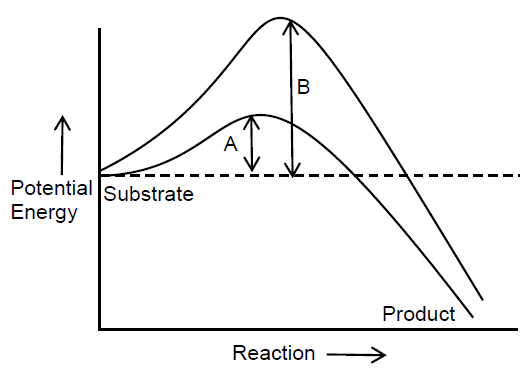Which of the following is the least likely to be involved in stabilizing the three-dimensional folding of most proteins?
1.
Ester bonds
2.
Hydrogen bonds
3.
Electrostatic interaction
4.
Hydrophobic interaction
Which of the following describes the given graph correctly?

1. Exothermic reaction with energy A in absence of enzyme and B in presence of enzyme.
2. Endothermic reaction with energy A in presence of enzyme and B in absence of enzyme.
3. Exothermic reaction with energy A in presence of enzyme and B in absence of enzyme.
4. Endothermic reaction with energy A in absence of enzyme and B in presence of enzyme.

To unlock all the explanations of 38 chapters you need to be enrolled in MasterClass Course.

To unlock all the explanations of 38 chapters you need to be enrolled in MasterClass Course.
Which one of the following statements is correct with reference to enzymes?
1. Apoenzyme = Holoenzyme + Coenzyme
2. Holoenzyme = Apoenzyme + Coenzyme
3. Coenzyme = Apoenzyme + Holoenzyme
4. Holoenzyme = Coenzyme + Co-factor
Which of the following are not polymeric?
| 1. | nucleic acids | 2. | proteins |
| 3. | polysaccharides | 4. | Lipids |

To unlock all the explanations of 38 chapters you need to be enrolled in MasterClass Course.

To unlock all the explanations of 38 chapters you need to be enrolled in MasterClass Course.
Cellulose, the most important constituent of plant cell wall, is made of
| 1. | Unbranched chain of glucose molecules linked by α 1, 4 glycosidic bond |
| 2. | Branched chain of glucose molecules linked by β 1, 4 glycosidic bond in straight chain and β 1, 6 glycosidic bond at the site of branching |
| 3. | Unbranched chain of glucose molecules linked by β 1, 4 glycosidic bond |
| 4. | Branched chain of glucose molecules linked by α 1, 6 glycosidic bond at the site of branching |
Which of the following bio-molecules is strictly not a polymer?
| 1. | Carbohydrates | 2. | Proteins |
| 3. | Fats | 4. | Nucleic acids |

To unlock all the explanations of 38 chapters you need to be enrolled in MasterClass Course.

To unlock all the explanations of 38 chapters you need to be enrolled in MasterClass Course.
Most of the polymerization reactions result from:
| 1. | Redox reactions | 2. | Dehydration synthesis |
| 3. | Hydrolysis | 4. | Isomerization |

To unlock all the explanations of 38 chapters you need to be enrolled in MasterClass Course.

To unlock all the explanations of 38 chapters you need to be enrolled in MasterClass Course.
The R group in a proteinaceous amino acid is hydroxymethyl. This amino acid:
1. is not an essential amino acid
2. is not genetically coded for
3. is involved in disulfide linkage
4. is acidic in nature
The given compound:
| 1. | is a storage product in archaea |
| 2. | is the source of energy in fungi |
| 3. | is present in the cell walls of gram negative bacteria |
| 4. | is a structural component of plasma membrane |

To unlock all the explanations of 38 chapters you need to be enrolled in MasterClass Course.

To unlock all the explanations of 38 chapters you need to be enrolled in MasterClass Course.
Identify the given nitrogenous base:
| 1. | Adenine | 2. | Guanine |
| 3. | Thymine | 4. | Cytosine |

To unlock all the explanations of 38 chapters you need to be enrolled in MasterClass Course.

To unlock all the explanations of 38 chapters you need to be enrolled in MasterClass Course.








